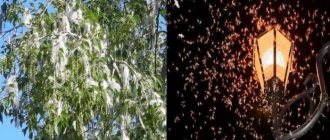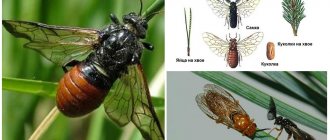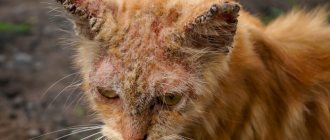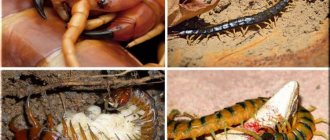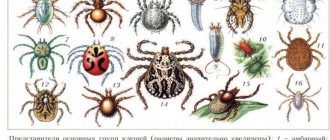Kinds
There are two forms of pest damage to grapes:
- Root. Most often it is found on the so-called dew roots, located in the most breathable layer of soil (at a depth of 25-30 cm). On thin young roots, swellings or nodules appear, on thicker ones - swellings, which subsequently crack. Through such wounds-cracks, pathogens, fungi and bacteria enter the plant, causing the roots to rot and die. If there is a lot of phylloxera, it looks like yellowish dust on the roots.
- Leafy . It develops on leaves, on the underside of which swellings appear - the so-called galls. These pest larvae penetrate directly into the mesophyll of the leaf. With severe infection, the leaves become deformed, curl, and fall off.
Depending on the type of grape on which phylloxera lives, it goes through a complete or incomplete development cycle. Let's take a closer look.
How do signs of infection appear?
By secreting saliva from the proboscis, pests contribute to changes in the structure of plant tissues, which is explained by the presence of certain enzymes in the liquid. Examining the thin fibrous roots, you can notice nodules and swellings, which very soon begin to die. On thicker conductive roots, nodules appear, which eventually crack over their entire surface. In themselves, such damage is not very dangerous, but it is through them that bacteria and microbes penetrate inside, causing rotting of the affected part of the grape rhizome.
If the vine is affected by leaf phylloxera, swellings should be looked for on the leaf blades and young shoots of the plant, and the presence of winged insects is often noticeable to the naked eye, you just have to look at the back of the leaves.
Full development cycle
Found on some American-European hybrids and American grape varieties. Let's consider its stages:
- Phylloxera larvae that overwinter on the roots in the spring (when the air warms up to 12-13 ° C) become adult wingless females that partogenetically (that is, not sexually) lay eggs.
- The larvae that hatch from them parasitize the roots, develop, become adult females and lay eggs again.
- Starting from the end of June, some larvae degenerate into a transitional form - nymphs. They crawl to the surface and develop into winged females.
- There, eggs of two types appear from them, from which sexual individuals emerge - females and males.
- As a result of mating, only one egg remains, hidden for the winter in the wood of the bush. In spring, a leaf-shaped larva emerges from it and settles on young leaves.
- In leaf galls, the larvae develop into females capable of asexual reproduction.
- They lay eggs, from which new larvae hatch and crawl onto new leaves. Some of it goes down to the roots.
Thus, the full development cycle of an insect takes 2 years and includes a change in feeding site from roots to leaves and back.
Forum statistics
217330 Messages in 1651 Topics from 5852 Users. Latest user: skynet797 Latest message: “Athos is an extremely early g.f. ..." ( Today at 20:50:38) Latest messages on the forum.
Now on the forum
74 Guests, 24 Users
Users in the last 15 minutes: Verona, Medvedev Yuri Viktorovich, SergL52, Klyuchi, DSW, Alexander_89, Elena Z, AAV, Evgeniy30, Soshnin Yura, Kenig, dayton, IVK, Serzh1978, thanatos, Grinya, kdm57, tsv, Helga, Seelena, lomakin1969, Sergey 1965, Kan-Temir, Inna161 [Blocked] [Section Moderator] [Forum Moderator]
Maximum online today: 120 . All-time maximum online: 2758 (28 July 2021, 17:22:51)
Users who visited the forum in the last 24 hours
Total: 253
(Visible: 252, Hidden: 1) 1963, Medvedev Yuri Viktorovich, SergL52, Keys, Alexander_89, Verona, DSW, Elena Z, AAV, Evgeniy30, Soshnin Yura, dayton, IVK, Kenig, Serzh1978, thanatos, Grinya, tsv, kdm57 , Helga, Seelena, Sergey 1965, lomakin1969, Kan-Temir, Inna161, Alexander150, Svetlana76, Alexander Vl., igor222, water, Saratov, Alexey V, Oleg56, serge, Belgorodets, Marina Protasova, Igor 31, zsb, therapist, Henry , DimaRostov, Ilya 77, Vladimir Berdnikov, Asterias, Evgeny 50, Sergey 61, DIL, Rafail, Igor Sergeevich, nick041, Dmitry Badaev, Yuri Gaivoronsky, Taker, Yura, Vasily1111, gardener, Lamo, y_fed, vikbublik, Nikolay Lipunov, Vasily 53, Svetla777, krasnovlad1, Naumov Igor, Valerie, Snezhinets, Berkut12345, VLADIMIR7512, Buba, Ivan Levin, Edurd, Cherkessk, Volgar, Alexander71, neposny, hanter64, YurSanych, Alexander Sh, igor11, Evgeniy16, DorontsovPeter, Mikhail77, Ana Toliy Sivkov, AlexandrGr, Den, gheo55, Erem, Sveta62, Yagodka, irahelm, Realist, Mark, Natalia Nikolaevna, Zaur, Sergeevich, Alexander K, livkrivc, bigkukuruzina, Svetlana Streletskaya, Sergey Fomin, Linx, Enych, vlad51, Evgeniy52, sor.vit, Ali, Tatyana A., Verbitsky E.I., N.A. Sokolov, Korotina Svetlana, Tar-nik, Sergey2017, Vova Kapran, Bubulyator, Raisa Yurievna, Leonidych, Orel, LeXa_KoT, SANYCH, Dmitry 77, Alexander 61, 64nikolay64 , Skif, Antrikan, uzeir, Vika, Igor F., romabcm, Yuri 36, Sergey Chistokletov, TIS, serginio, Oksana Kopp, Eduard., Filippov Oleg, Alexey S, Valentina Ivanovna, Sergey Yuryev, TITOVA LYUBOV, Pioneer, Saisan, formula1, Nikolay Vasilievich, atseton, VeraNiK, , Agryzkov Alexey, Oleg34, Efimych, Tatyana B, Victoria Aleksandrovna, Lyubov S., vitos, L.A.P., Anatoly uy0mk, Vladimir Kostochkin, Zheka, Tikhy, Andrey 31, Sergey Tashchiyan, Romik, Igor K, Rita, Nadezhda Grig, Sergey 31, Dmitry Belarus, vladimirvrn, Timofey, Alexander Zinoviev, Dmitry-Ivanovich, vladimirM, alexsandr, Lydia58, Pirko Alexander, Yuri Semyonov, Vladimir-kanevskaya, Yuri72, Andrey76, Natasha , Timekeeper, amelanchier, nau_63, Nadya, Sernik, Alexander Smirnov, rivaN, slavalimon, Grandfather Igor, Liliya Bazilevskaya, alexss, Alex65, Alexander Gai, SvetlanaV., ViktorKG, aladu6ek, Andrey68, nadia, Izhitsa, Pavel 64, Mikhail Shtukkert, f i g a r o, Elvira2017, Vladimir VS, Ewgeniy, Pyzhov, Mikhail Alekseevich, Vasily V., cecet71, Wintel, MaxL, Igor M., Vladimir ++, Mst, Maximilian, Amber7394, psv1960, Liza, belogor53, Serg1707 , Andrey Gladilin, Kazak, mers, marlin64, skier, Sergey Fer, Victor55, Vitaly 70, Alexey Deminov, Ivan Shmelev, Alexander 65, Vladimir Buturlakin, Galina, SvetlanaBondareva, Scream1355, Sergey151, Mikhno Alexander, Svetlana Zaitseva, Tropinka, Valery155, turist792, Antagonist, Masha_gardener, Haus, Armagnac, ketch, asun16, Vladimir Kovba, Gela, max2008-01, Denisovich, Sveta, skynet797
Incomplete development cycle of grape aphids
On Asian and European grape varieties, phylloxera is not found on the leaves and only has a root form. Reproduction occurs in the same way as during the full cycle, but includes only its first 2 stages, which take place underground.
During the summer, root phylloxera produces 5-8 generations. The speed of development depends on external conditions. The most favorable temperature for pest reproduction is 25 oC. Under such conditions, one generation develops in two weeks. For comparison, at 13 °C - in 60 days. The depth of distribution of the pest in the soil also affects: if in the upper layers (up to 50 cm) 5-6 generations develop over the summer, then at a depth of 2 m - only 2-3.
Phylloxera vine
03/13/2019 Grape phylloxera ( lat. Dactylosphaera vitifoliae
) is an insect of the
Phylloxeridae
and is on the list of dangerous quarantine pests that can cause significant damage to vineyards.
The habitat of these pests was originally the northern and eastern United States. However, at the end of the 19th century, insects, along with grapes, were introduced to the European continent, Australia and New Zealand, and many countries in Asia and Africa. Currently, foci of phylloxera have been found in Crimea, Moldova and Ukraine.
The insect is a small aphid that, using a sucking mouthpart with a proboscis, pierces the leaves and tops of shoots (leaf form of the pest) or the roots of grapes (root form of the pest).
The greatest damage to grapes is caused by the root variety of aphids. Due to the damage caused by the pest, ugly growths and nodes form on the root system of the bush, which block the access of nutrients, disrupting the life support process of the plant, which invariably leads to its death.
Forms of phylloxera
The life cycle and lifestyle of these insects includes a very complex combination of different forms that constantly interact with each other.
Root form of phylloxera
This life form of aphids consists exclusively of females that live on the underground organs and root system of grapes.
Females do not have wings, and their body is colored greenish or brownish. The shape of the body is ovoid, the head has a long proboscis, with the help of which the pest pierces the fibrous roots of plants, sucking out the juice.
Phylloxera saliva contains substances that cause ugly growths and swellings to form on damaged grape roots. These malignant nodules interfere with the natural process of plant nutrition. In particularly severe cases, the root may die completely (usually a grapevine heavily infested with root aphids dies within 4-5 years).
For the reproduction process of the root phylloxera, fertilization is not required, so it reproduces without prior mating, laying oval-shaped yellowish eggs for 4-6 weeks.
An overwintered female root aphid is capable of laying up to 800 or more eggs during its life cycle, which depends on external factors (weather and nutrient medium), but its subsequent generations produce a much smaller number of embryos.
Under favorable conditions, the root form of phylloxera produces up to 5-6 generations of offspring.
Phylloxera eggs are oblong in shape and become brown or olive in color as they develop. They measure about 0.32 millimeters and take just over a week to develop.
The born root aphid reaches a length of up to 0.35 millimeters and, as it develops, goes through four molting stages. After emerging from the egg, she begins to lead an active and mobile lifestyle, immediately setting off in search of grape roots. For this purpose, insects sometimes come to the surface and are even capable of moving along the ground for a long time at a speed of up to 3 centimeters per minute.
An adult root aphid reaches a size of 1.35 millimeters.
Most often, these insects can be found closer to the end of the summer season, for which you should dig up the roots of the grapes to a depth of half a meter.
Leaf form of the pest
The leaf or gall form of phylloxera is found exclusively on grapevine hybrids native to the United States, so this aphid species does not typically feed on grapevine varieties grown in European countries. However, it is the leaf form of the pest that is considered the most dangerous, since it produces some of the offspring, which then colonize and damage the roots of the vine.
In the event that leaf phylloxera is unable to survive on European grape varieties or hybrids, it forms a winged generation of aphids that migrates in search of vineyards suitable for colony life.
The life cycle of a leaf gall is as follows: with the onset of spring, a wingless female individual, also called the May aphid or progenitor, emerges from an overwintered egg. As a rule, it colonizes the lower leaves of the grapevine (2-5 leaves) and begins to suck the juice from them. As a result, galls are formed on the surface of the leaf blades, which are green or reddish-colored concave formations the size of a pea.
Leaf phylloxera lays greenish eggs (up to 1200 pieces) in the galls, but on grape varieties and hybrids that are immune to the pest, their number can be significantly smaller.
After a little more than a week, a new generation of aphids emerges from the eggs, which leaves the galls and begins to move upward along the grapevine, colonizing more and more new leaves, and forming fresh galls on them. For example, aphids of the second generation already live on the middle leaves of the plant (7-22 leaves), and the third generation occupies higher “floors”.
Under favorable natural factors, the fourth and fifth generations of phylloxera may appear, which leads to complete infection of the grapes.
It should be said that each new generation of the pest is inferior to the previous one in terms of the number of eggs laid, however, with the mass reproduction of leaf-shaped aphids on grapes, galls cover not only the leaves, but also the petioles, tendrils and tips of the shoots.
The second generation of the pest, along with the leaf form, gradually begins to produce a generation that already includes insects of the root form (they have a longer proboscis). At the same time, the fourth generation of offspring already consists entirely of root aphids, which, with the onset of autumn, migrate en masse to the soil, where they settle near the root system of the grapes.
They feed by attaching to the roots and overwinter underground, demonstrating good adaptability to life in difficult conditions.
The leaf form of phylloxera dies with the onset of autumn.
Winged form of the pest
During the summer season, in the root aphid colony you can find insects (nymphs) with a thin and orange-colored body, on which the lateral rudiments of wings can be observed.
Especially many nymphs appear under favorable weather conditions (high air temperature plus relative humidity).
As the nymphs develop, the root phylloxera come to the surface, and in the final molt phase they transform into the winged form of the insect.
The winged form has a yellowish body color and reaches a length of about one millimeter. She has rather long legs and a pair of wings, with the help of which the pest is able to fly over short distances (up to 100 meters).
Among other things, the winged form has a well-developed sense of smell, which allows insects to quickly find suitable grape varieties.
As with root phylloxera, all members of the winged variety of aphids are female and have the ability to produce offspring without prior fertilization.
She lays two types of eggs: some smaller (from which males are born), and others larger (subsequently, females are formed from these eggs). Females go through four developmental phases before reaching sexual maturity.
Born males reach a length of 0.28 millimeters and are yellow in color, while female representatives are painted in a lighter tone (their body length reaches 0.5 millimeters).
Males and females are the so-called sexual form of phylloxera, whose life cycle lasts about 8 days.
In the life cycle of the pest, this form of existence is the only one in which the process of mating and fertilization of eggs occurs. In this case, the female individual of the sexual form lays only one single egg, which she usually hides in crevices of the bark on old trees, where it overwinters.
The egg is olive or brown in color, reaches a length of 0.27 millimeters and has an oblong shape.
Thus, the two-year life cycle of aphids begins underground and includes the root and nymph forms, the winged form, the winter egg, the leaf form and through this the return of the insects to the soil.
At the same time, like many insects inhabiting our planet, phylloxera has several different biotypes, which in external characteristics may differ slightly from each other, which depends mainly on the varietal of the grapes infested by pests.
Distribution of phylloxera
The spread of aphids occurs mainly with the help of the winged variety, which, flying from plant to plant, infects them with its larvae (vagrants or leaf form of phylloxera).
Research conducted by scientists has clearly demonstrated that winged aphids can be easily transported by strong winds, covering distances of up to 30 (!) kilometers. In addition, aphids are able to migrate with the help of animals, birds, garden tools, clothing and shoes, or spread throughout the area along with irrigation water and mud flows.
The spread of phylloxera over longer distances is facilitated by the shipment of planting and grafting material and soil infected with the pest.
Pest control methods
The pest prefers light and well-loosened soils, so it is practically not found on heavy clay soils.
Phylloxera has a miniature size (from 0.25 to 2.25 millimeters) and a yellow-greenish body color, so insects are very difficult to detect with the naked eye. Aphids are excellently camouflaged, blending in with vegetation.
Effective control of phylloxera is also complicated by the fact that one of the forms of insects leads an underground lifestyle, and therefore the use of insecticides to counteract this pest is not effective and is an insoluble problem today.
Therefore, in case of severe infestation, all grape bushes affected by aphids should be uprooted, after which the entire area must be thoroughly treated with chemical reagents. At the same time, a new grape plantation should be planted in this place no earlier than after 5-6 years.
The currently practiced use of volatile and flammable carbon disulfide, unfortunately, kills not only aphids and their eggs, but also harms the grapevine itself.
Preventive plant protection measures
The following measures must be taken against phylloxera infection of a vineyard:
· From time to time, monitor the condition of the grape bushes and their roots
· Carry out careful selection of planting material
· Plant cuttings deeper, while pre-disinfecting them with insecticides
· Trim infected areas and destroy them by burning them over an open fire
· Replace surface soil with river sand to create a special cushion that protects the root system of the vine
· Plant grape varieties that demonstrate resistance to aphid infestation
· Perform timely disinfection of garden equipment, tools, clothing
One of the effective methods of resisting phylloxera is flooding the root system of plants (for a period of one and a half to two months) during the cold period.
Treatment of plants with pesticides
If foci of plant infestation by leaf aphids are detected, they should be treated at least three times:
· In the phase of formation of one or two leaves (as a rule, this occurs in early May)
· In the leafing phase (at the end of May)
· In the phase of green mass formation (about 20 leaves). Usually the third treatment is carried out at the end of June
Insecticides for treating grapes include the following preparations: Zolon, Mitak, Confidor, Marshall, Actillic.
In addition, once every two years, with the onset of the first spring warmth, it is advisable to treat the vineyard with a two percent insecticidal-fungicidal solution DNOC (a systemic drug that allows you to get rid of other wintering insect pests).
At the same time, some winegrowers, in order to resist phylloxera infection, fumigate the surface layer of soil on the site with dichloroethane.
Traditional methods of pest control
It has been proven that aphids cannot tolerate the strong smell of parsley, so this crop should be planted between the rows and along the perimeter of the vineyard based on the principle: the more, the better.
Among other measures, it is recommended to use the following types of work:
Treatment of grapes with copper sulfate
· Spring treatment of the vineyard with a solution of iron sulfate (dilute 500 grams of sulfate in 10 liters of water). This solution should be used to water the soil, having previously formed furrows or grooves up to 25 centimeters deep in it. After moisture has been absorbed, the grooves should be buried and the surface leveled.
· Autumn treatment of plants with urea with the addition of fungicides. Spray on bare vines at least twice (every 10 days)
· Treatment of grapevines with decoctions and infusions of tobacco (shag) or field chamomile
What are the risks of infection?
The leaf form of phylloxera does not affect the quality of the crop. Its danger lies in the fact that the developed pest larvae can move to the roots. Due to a lack of nutrients, the shoots ripen worse and do not reach the optimal size, which affects the winter hardiness of the plant.
In turn, root phylloxera damage can no longer be cured. On a diseased plant, there is a gradual suppression of the bush, slower growth, and a decrease in yield. The bush is doomed to death. A phylloxera invasion can completely destroy a vineyard in 3-8 years.
Important! Grape phylloxera is a quarantine pest, the import of which into the country is prohibited.
On what soils does infection occur?
Most of all, phylloxera loves loose, water- and breathable soils. Therefore, the maximum amount of the pest is found at shallow depths. Less commonly, grape aphids are found on dense, poorly permeable soil (clayey, silty, with stagnant water). It also does not tolerate sandy soils, which winegrowers take advantage of by adding sand when planting bushes.
Spread of grape aphids and methods of control
The main source of aphid spread is planting material, namely larvae and eggs overwintering in roots and wood. Pathogens in the leaf form can be carried by the wind, as well as by animals or humans (on clothing, tools). The roots become infected when cultivating the soil (through a tool, with water during irrigation).
It is believed that the European grape variety Vitis Vinifera and the American Vitis Labrusca are resistant to the leaf form of phylloxera, and the American Vitis Riparia is resistant to the root form. Hence, the optimal solution against the spread of the pest is to use not rooted, but grafted seedlings with such a combination that both the roots and the top are stable.
The leaf form is combated with insecticides (Aktellik, Bi-58 new, Fastak, Zolon). These drugs work when the larvae emerge from the galls on the leaves, that is, they destroy the pest by contact. Systemic and intestinal drugs are ineffective against phylloxera, since its nutrition is extraintestinal. Spraying with insecticides is carried out twice during the growing season.
Basic methods of struggle
Gardeners independently select the most suitable one.
Wet
This method is used for young plants. Involves flooding of roots during cold periods. Adults and larvae die from excessive moisture. However, such exposure does not protect against insect eggs. To increase the effectiveness of this type of processing, special emulsions are used.
Fumigation
This involves calling the sanitary service, which uses special spraying preparations. After such treatment, insects and their larvae die. Also, this type of treatment has a negative effect on pest eggs.
Chemical treatment
Allows you to eliminate even complex types of grape lesions. To eliminate the problem it is necessary to use special chemicals
"Fastak"
The substance in the form of an emulsion is suitable for treating the garden. Used against pests, including grape aphids. It has a contact-intestinal effect and allows you to remove most of the pests in a short time.
"Fozalon"
A chemical preparation that is produced in the form of an emulsion. Used to remove pests and rodents. Can be used to remove both root type pests and leaf phylloxera.
"Aktellik"
The drug is widely used against all types of aphids. It does not have a negative effect on the crop and can be used every 10-15 days without harm to the plants.
"Kinmiks"
The drug is intended to combat leaf-eating pests. Eliminates aphids without harming the crop. Can be used for frequent processing, does not harm insects and pets.
"Confidor"
The drug is not destroyed when exposed to direct sunlight. It has the property of eliminating adults as well as their larvae. The spraying procedure must be repeated every 15 days. After precipitation falls, spraying is repeated.
"BI-58"
The drug is not recommended for use near beneficial insects. Has the property of being quickly washed off with water. Effective against larvae and adults. Prevents larvae from hatching from eggs. Allows you to eliminate up to 90% of grape aphids.
"Marshal"
Effective in the fight against phylloxera, allows you to remove the pest at the egg-laying stage. A positive result is achieved 2 hours after application. Can penetrate deep layers of leaves, preventing re-infestation by insects.
"Zolon"
The drug has a paralyzing effect on the sucking pest. Reduces the ability to move, resulting in the death of the insect. Can be used against all types of aphids on grapes. After spraying, it is necessary to re-treat the crop 10 days later.
"Kinmixon"
The drug is intended to combat leaf pests. Allows you to destroy insects within 2-3 hours after treatment. A positive result lasts up to 3 weeks. When precipitation occurs after treatment, it tends to be washed off, and it is necessary to re-apply.
Preventive actions
The main method of preventing the appearance of a pest is the correct selection of seedlings. To do this you need:
- do not buy seedlings from farms in areas of severe infection;
- choose phylloxera-resistant varieties;
- make a choice in favor of grafted rather than native root crops.
Before planting, it is recommended to treat the cuttings for several minutes in a solution of insecticidal preparations. It is important not to overdo it here: too strong a dose can cause damage from which the plant will take several months to recover.
Experts also give the following advice: if a seedling is suspicious, but the variety is valuable and you want to preserve it, you can plant it in a hole with sand and at the same time prepare a stable rootstock. Get vaccinated in a year.
As a preventive measure for root phylloxera, a technique called catarrhosis is used - removing all dew roots on the plant to a depth of 20-25 cm. This procedure is designed to stimulate the development of the root system and increase the bush’s resistance to adverse environmental factors.
Traditional methods
If the pest appears in small quantities, you can use proven traditional methods.
Solutions
The use of solutions is used to spray the vines. The prepared solution must be used on the same day.
Soapy
For application, a solution of laundry soap is used. To do this, you need to dilute a bar of laundry soap in a bucket of warm water and treat the bush. Particular attention should be paid to the back side of the leaves. Repeated treatment must be carried out after 14 days.
From the ashes
The use of wood ash repels aphids and prevents their re-formation. This method can be used for both above-ground and root application.
To spray the vine, 1 kilogram of the substance is dissolved in a bucket of water and, using a hand-held coarse spray, the treatment is carried out.
To eliminate pests from the roots, it is necessary to water the soil with the resulting solution. Birch wood ash is suitable for all grape varieties and eliminates insects in a short period.
From the peel of citrus fruits
The use of citrus fruits helps repel phylloxera. Orange or lemon peel can be used for preparation. 500 grams of peel is poured into 1 liter of water and left for a day. The resulting solution is mixed with clean water 1:3, and the treatment is carried out.
From the tops of nightshade plants
Some plants have a repellent effect on insects. These plants include tomatoes and potatoes. The solution must be prepared as follows: chop 1 kilogram of grass and add a bucket of water. Leave for a day and strain. The resulting solution is sprayed onto the bush. You can re-process every 10 days until you get the result.
See also
Description and rules for growing grapes of the Anthony the Great variety
Read
Important. The same result can be achieved if you use a solution of garlic water. Prepared according to the following recipe. Chop one hundred grams of garlic and add a liter of water. The resulting solution is infused for a day, after which it is mixed with water in a ratio of 1:3 and the bushes are treated.
Tobacco
To prepare the solution, you must use special tobacco dust, which can be purchased at a store where insecticides are sold. To prepare, you need to mix a glass of tobacco dust in a liter of water and leave until completely dissolved. After which the resulting infusion is dissolved in 5 liters of water and the vines are sprayed.
Planting parsley
Parsley has a repellent effect on harmful insects. To combat aphids, it is necessary to plant crops under grape bushes. During the flowering period, parsley contributes to the appearance of a bright aroma.
You can also achieve the same result by planting dill or marigolds with a bright smell.
Important. If the crop is severely damaged, the bush must be removed. Roots that may act as a further carrier of the disease are also uprooted. Removed vines must be burned.
Misdiagnosis
External signs of damage by the leaf form of grape aphids can be confused with the activity of other pests: thrips or grape itch.
When a bush is affected by itching, tubercles appear on the upper side of the leaf, and then the down that appears below is not yellow, like from phylloxera, but brown-red.
Like phylloxera, thrips appear on the undersides of grape leaves as small swellings on the leaves. However, they do not then develop yellow growths, like phylloxera.
Forms of the disease and characteristic signs
There are several forms of the disease.
Root
To identify infection of grape roots with phylloxera, it is necessary to free the upper part of the root system from soil at the end of July and carefully examine it.
An infected root has the following signs: small swellings appear on thin roots, and clusters of aphids are visible on large roots. The root dries out and the bark crumbles.
Leafy
The leaf form is much easier to detect than the root form. If spherical, convex, rough spots appear on the leaves on the inside of the leaf, this is a sign of the first infection.
Winged
Winged aphids also attack leaves by laying eggs on the inside of the leaf.
Resistant varieties
Breeders do not stand still and are constantly developing varieties that are resistant to phylloxera in one form or another.
Thus, the following proprietary root varieties are distinguished by their tolerance to both forms: Cabernet AZOS, Kubanets, Pamyati Zotkina, Krasnostop AZOS, etc. Under certain conditions, with proper agricultural technology, the following varieties have proven themselves well: Muscat, Shokoladny, Aurora Magaracha, Jubilee Magaracha, Antey, Jubilee Zhuravlya, Nugget, Moldova, Muscat Hungarian, etc.
It is important to note that all of the above varieties are self-rooted. And as already mentioned, the optimal, albeit more expensive, solution for preventing phylloxera is vaccinations. For example, Kober-55 is used as a rootstock.
Common mistakes when fighting phylloxera
As with other pests and diseases of fruit crops, the main mistakes gardeners make are as follows:
- incorrect agricultural practices that weaken the plant;
- incorrect choice of seedling variety without taking into account its resistance to the pest and climatic conditions;
- the use of chemicals that are not effective in controlling a specific pest (in this case, phylloxera);
- the use of outdated control methods that are no longer recognized as working (for example, the use of root “covers” when planting).
Reasons for appearance
Various factors can provoke the formation of a pest.
Climate
The pest can appear in dry weather. The insect can also be carried into the garden area by the wind.
Violation of agricultural cultivation techniques
Before planting grapes, it is necessary to neutralize the planting site, this will reduce the risk of infection with grape aphids. Infection can also occur as a result of a lack of the required amount of nutrients. Infected crops do not have immunity to fight the pest and die.
Wrong choice of planting material
The reason that provokes infection of the crop is incorrectly selected planting material. Pest eggs can remain dormant for several years and hide on seedlings.
It is necessary to carefully examine the root and cuttings. There should be no seals or growths on it, in which larvae can hide.
The insect also causes a rotting process, which leads to the complete death of the roots.
See also
Methods for controlling wasps during grape ripening, how to protect them
Read
Important. Infected grapes should not be used as a mother plant. The larvae can move along with the cuttings and attack the seedling.
Infected inventory
Before each crop treatment, it is necessary to process the equipment that is used. Very often, pest eggs are hidden in the ground and can settle on a shovel.



